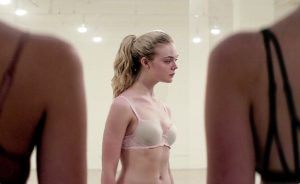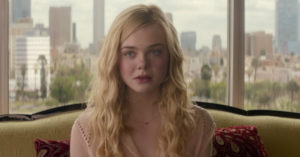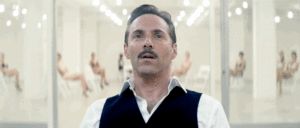 Attend: Now Playing
Attend: Now Playing
The Neon Demon | Nicolas Winding Refn | France, Denmark, USA | 118 minutes
Now Playing at AMC Fitchburg 18»
James Kreul was one of the few Madfilm Meetup attendees to like Nicolas Winding Refn’s The Neon Demon. He argues that if you can set aside genre expectations and appreciate images in the moment, there’s much to enjoy in the film.
I almost didn’t write a review of The Neon Demon after our Madfilm Meetup at Sundance Cinemas on June 28 because I thought it would leave its three Madison theaters by the time I posted it. But now that I know that it will play one more week, I want to make sure at least some of you take the opportunity to see it on the big screen.
As has been well reported by now, Amazon Studio’s wide release for the film (783 theaters) has been a wild miscalculation in strategy producing an opening weekend per-theater box office average of $775. AMC Fitchburg 18 will dedicate a theater to a limited number of screenings for a second week, but as expected the film will not continue at Sundance or Marcus Point.
The Neon Demon‘s strengths are pictorial. The cinematography (by Natasha Braier) is fantastic, but more importantly the film is organized around distinct, vivid tableaux rather than a particularly realistic or engaging dramatic arc. That organization is driven by shifting genre expectations, but the conventions simply provide a starting point rather than a conventionally fulfilling genre experience. You will likely be disappointed if you want either realism or genre satisfaction. But if you can shift gears and patiently appreciate the images in the moment, there’s much to enjoy in The Neon Demon.
 Jesse (Elle Fanning) is a fresh-off-the-bus aspiring model in Los Angeles. She arranges to have photos taken to distribute to aspiring agents, and meets makeup artist Ruby (Jenna Malone), who is immediately intrigued by this new fresh face. Ruby takes Jesse to a party where she introduces her to experienced models Gigi (Bella Heathcote) and Sarah (Abbey Lee). The contrast between Jesse and the veterans could not be more pronounced: Gigi and Sarah are products of the beauty industry and plastic surgery who have a cynical outlook about themselves and their career; Jesse is the untouched, unblemished beauty who doesn’t know much but she believes that she’s pretty enough to be successful.
Jesse (Elle Fanning) is a fresh-off-the-bus aspiring model in Los Angeles. She arranges to have photos taken to distribute to aspiring agents, and meets makeup artist Ruby (Jenna Malone), who is immediately intrigued by this new fresh face. Ruby takes Jesse to a party where she introduces her to experienced models Gigi (Bella Heathcote) and Sarah (Abbey Lee). The contrast between Jesse and the veterans could not be more pronounced: Gigi and Sarah are products of the beauty industry and plastic surgery who have a cynical outlook about themselves and their career; Jesse is the untouched, unblemished beauty who doesn’t know much but she believes that she’s pretty enough to be successful.
Jesse is correct. Big-time agent Roberta Hoffmann (Christina Hendricks) signs Jesse immediately despite her gaudy sample photos. Roberta sends Jesse to a “closed-set” session with hot photographer Jack (Desmond Harrington), who gives Jesse her first experience with that fine line between the profession and exploitation.
The narrative momentum slows down significantly at this point, and instead of Jesse as a goal-oriented protagonist we have Jesse as the central figure in a series of events which provide variations on a theme. Jesse has a visceral impact on everyone she meets in the industry, so the only real drama is whether or not she will be personally corrupted by this new power.
Almost everything else interesting at this point is tangential, rather than crucial to a linear plot. This includes an underdeveloped relationship with young photographer Dean (Karl Glusman) and a wonderfully strange turn from Keanu Reeves as the manager at Jesse’s cheap motel. Our emotional engagement depends on the degree to which we are willing to play with the very broad use of conventions in two genres: melodrama and horror.
Our engagement with the melodrama, in turn, depends on our willingness to submit to the power of color and texture. Douglas Sirk and Nicholas Ray famously punctuated their 1950s melodramas with vivid, saturated colors, which subsequently influenced more recent filmmakers with a melodramatic bent like Pedro Almodovar and Todd Haynes. With Refn, you often get the opposite: wildly engrossing compositions of vivid, saturated colors punctuated by melodramatic conventions.
After Ruby introduces Jesse to Gigi and Sarah at the party, she suggests that they leave the bathroom at the club to check out the show that is about to start. I can’t explain exactly what happens in the show sequence, but I can say that the experience it provides is crucial to enjoying The Neon Demon. As such, it provides a convenient litmus test early on to let you know if this film is for you. For me, the sequence, and others like it, took the film into Kenneth Anger territory, delivering almost pure visual pleasure.
 Narrative is not completely displaced by abstraction, but the narrative pleasure arrives in a series of moments rather than a three-act dramatic arc. One particularly fantastic scene involves Jesse and Sarah auditioning to walk the runway for a show by a self-absorbed fashion designer (Allesandro Nivola). The designer doesn’t even lift his head to watch Sarah walk, but he is completely mesmerized by Jesse. Nivola’s glances and sounds are priceless (the blog My New Plaid Pants has posted a series of .gifs dedicated to this moment in the film). Moments with stylized performances like this might not be enough to engage every viewer, but I found them both stylistically and narratively satisfying.
Narrative is not completely displaced by abstraction, but the narrative pleasure arrives in a series of moments rather than a three-act dramatic arc. One particularly fantastic scene involves Jesse and Sarah auditioning to walk the runway for a show by a self-absorbed fashion designer (Allesandro Nivola). The designer doesn’t even lift his head to watch Sarah walk, but he is completely mesmerized by Jesse. Nivola’s glances and sounds are priceless (the blog My New Plaid Pants has posted a series of .gifs dedicated to this moment in the film). Moments with stylized performances like this might not be enough to engage every viewer, but I found them both stylistically and narratively satisfying.
Then there are moments when I just got lost in the image. That doesn’t happen to me very often anymore. I’m perfectly aware that after Drive and Only God Forgives that Refn is kind of painting by numbers at this point, but I still find the images seductive and exhilarating. His films now often feel like my memory of Michael Mann’s Thief (1981, with the Tangerine Dream score), so they also have a tint of nostalgia even when they don’t explicitly reference the 1980s.
When Jesse finally has to abandon the motel, Ruby offers her a room in the mansion where she is housesitting. While there has been overtones of dread throughout, here we explicitly venture into the genre of gothic horror. I would find it hard to believe that horror fans would find the third act satisfying. Instead, the genre conventions again provide starting points for stylistic flamboyance and even more audacious satire of fashion world values.
A few recent precedents came to mind once the film makes the shift to horror conventions. First was Hélène Cattet and Bruno Forzani’s Amer (2009) which similarly mixed the story of a young girl discovering her sexual powers with the conventions of gothic horror. Second was Harmony Korine’s Spring Breakers, which mixed youth culture satire with crime genre conventions. Both of those films, like The Neon Demon, are admittedly least successful when they abandon image and texture and try to connect the dots in terms of plot and genre conventions. They’re all good films, but they could have been great films with just a little more faith in the image.
A last film that came to mind that would make a great double bill with The Neon Demon was Anna Biller’s The Love Witch, which debuted at the 2016 Wisconsin Film Festival and has subsequently garnered significant attention on the Festival circuit. In some ways, The Love Witch is the film that The Neon Demon wants to be: aesthetically rich and pleasurable, playful with genre conventions, and satirical of attitudes about female sexuality. The key difference is that despite two female co-writers on The Neon Demon, Refn’s film never feels like anything other than a male fantasy (with disappointing doses of sexism and homophobia). Biller’s film, on the other hand, not only beats The Neon Demon in the color and texture department, it also has much more to say about its similar subject matter from an insightful female perspective.
Perhaps the deepest flaw in The Neon Demon is that its final tableau and denouement concerns characters that we’re the least interested in: Gigi and Sarah. This makes logical sense in terms of the end game of the satire, but without Jesse or Ruby present the climax fails to have much resonance beyond conceptual resolution.
Despite those flaws, you should see The Neon Demon if you get a chance, especially on the big screen. A colleague at the Meetup gave the film an audible raspberry when summarizing her response to her friends. That kind of response makes it worth seeing, too.